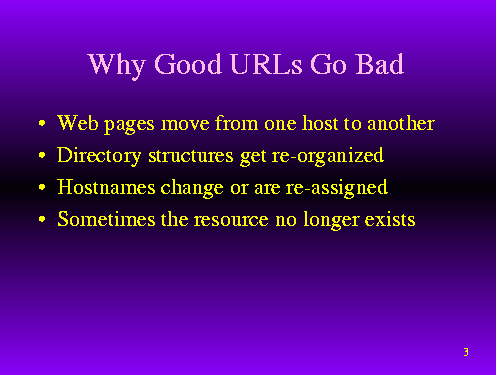
Click slide for next, or goto previous, first, last slides or back to thumbnail layout.
This slide lists some of the reasons why URLs become "stale", that is, a once-valid URL either becomes invalid or doesn't refer to the same thing it used to.
Web pages move ... this is partially the result of poor planning (when people put pages out on a web server without arranging for a server to be provided, at that address, in the long term). Looking at it another way, it's very quick and easy to put your web pages out on the net where everybody can see them, but much harder to ensure that they'll be around for awhile. So many authors don't bother, at least not at first. Moving the resource later on (say, if it becomes popular) doesn't work well because it's the original URL that becomes popular.
Directory structures get re-organized... if you use a directory structure to organize your web pages, sooner or later you need to rearrange things. When this happens, the old URLs become invalid. There's a related problem that multi-file documents get reorganized also. For instance, this slide show will certainly be revised at some point. You might make a link to this page as being the "Why Good URLs Go Bad" page, but in the revised presentation, the 3rd slide might be entirely different.
Hostnames change... InterNIC's revocation of some domain names, has caused considerable concern among network librarians. If you can't be assured of keeping your domain name, how can you make sure your URLs won't change?
Sometimes the resource no longer exists... it's worthwhile to point out that a large number of "stale URL" problems aren't due to the fact that the resource has moved or been renamed, but because it was removed or erased. We can't solve every problem...
Click slide for next, or goto previous, or back to thumbnail layout.